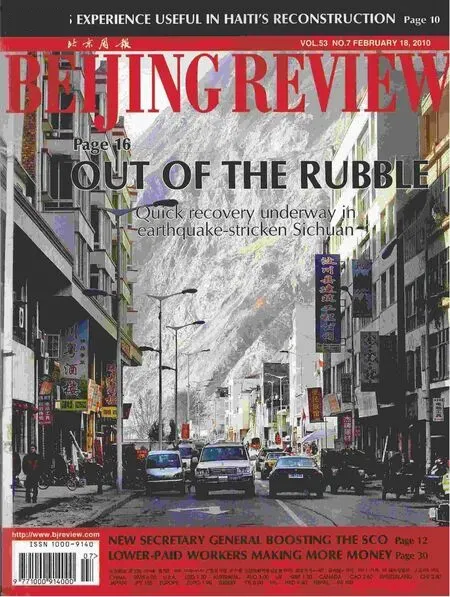The Wenchuan Phoenix
By HUANG WEI
On May 12, 2008, the biggest earthquake in China in 60 years,measuring 8.0 on the Richter Scale, hit the more than 100,000-square-km area that has Yingxiu Town in Wenchuan County,Sichuan Province, at its epicenter. After more than a year’s rebuilding, about 100 villages and towns in the disaster area have taken on a dynamic new look.
Full credit should be given to the Chinese Government’s quick moves to restore the quake-affected areas. Soon after the earthquake,the objectives of “an initial recovery in three years, full revival after five and all-round prosperity after 10” in the disaster area were set.A reconstruction campaign involving nationwide participation and the largest-ever input of funds and manpower were put into place in the shortest possible time.
In counterpart assistance, more than 100,000 people from 19 donor provinces and municipalities in prosperous central and eastern regions were dispatched to hardest-hit counties in Sichuan, Gansu and Shaanxi provinces to help in rebuilding. Many of the enterprises involved have also taken part in the construction of Olympic venues in Beijing and World Expo venues in Shanghai. Some have participated in the post-earthquake reconstruction of Tangshan in Hebei Province, where a massive 7.8-magnitude temblor killed more than 240,000 people in 1976. Many of those taking part in the reconstruction efforts are experienced managerial and technical personnel.
The Central Government prescribed that each donor province’s annual aid volume should be no less than 1 percent of its year-earlier fi scal revenue. On this basis, economically developed Guangdong and Shandong provinces gave 8.2 billion yuan ($1.2 billion) and more than 10 billion yuan ($1.5 billion) respectively to the worst-affected Wenchuan and Beichuan counties in 2009. Total aid available from the 19 donor provinces and municipalities exceeded 70 billion yuan ($10 billion).
Before the start of the 2009 autumn semester, nearly 70 percent of the more than 2,000 primary and middle schools destroyed in the earthquake had been rebuilt, allowing more than half of the students in the disaster area to resume classes in new or repaired school buildings. By the beginning of this year, 99.8 percent of more than 1.2 million rural residents had been moved into permanent new apartments. Industrial enterprises in the disaster area have resumed production, and the local industrial structure has already been optimized. Thanks to the implementation of the reconstruction projects,the growth rate of the disaster area was faster than Sichuan’s average level in 2009.
In today’s Wenchuan, local residents are reclaiming life amid a construction boom. Wenchuan’s rapid revival is a vivid manifestation of China’s ability to pool national strength to cope with major challenges. It also presents an excellent example of a post-disaster reconstruction model with Chinese characteristics. ■

